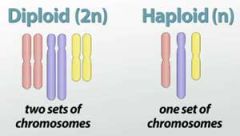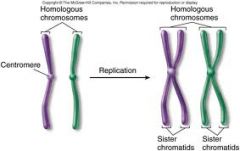![]()
![]()
![]()
Use LEFT and RIGHT arrow keys to navigate between flashcards;
Use UP and DOWN arrow keys to flip the card;
H to show hint;
A reads text to speech;
66 Cards in this Set
- Front
- Back
|
Sperm |
male reproductive cell |
|
|
Egg |
Female Reproductive Cell |
|
|
Fertilization |
The process of uniting sperm and egg is called fertilization |
|
|
Gametes |
Reproductive cells such as sperm and eggs |
|
|
Theory to why sperm/egg only have half of the chromosomes than a cell within a multicellular organism? |
During the formation of gametes (reproductive cells such as sperm/egg) there must be a distinct type of cell division that leads to a reduction in chromosome number. They must contain half of the usual number of chromosomes. Then, when sperm and egg combine, the resulting cell has the same chromosome number as its mother's cells and its father's cells have. |
|
|
Meosis |
The nuclear division that leads to a having of chromosome number and ultimately to the production of sperm and egg |
|
|
The Drosophila melanogaster (fruit fly) and its important to the theory of Meosis |
it lead to the realization that each organism has a characteristic number of chromosomes
- total of 8 chromosomes in Drosophila cells (there are 5 distinct types distinguished by size and shape)
- 3 always occur in pairs - In males there is an unpaired set of chromosomes (females lack Y chromosome)
|
|
|
Sex Chromosomes |
The X and Y chromosomes associated with an individual's sex |
|
|
Autosomes |
Non-sex chromosomes |
|
|
Homologous Chromosomes/ Homologs |
Chromosomes that are the same size and shape
They are similar in content as well as in size and shape. Homologous chromosomes carry the same genes
Homologous chromosomes carry the same genes, but each homolog may contain different alleles |
|
|
Alleles |
The versions of a gene found on homologous chromosomes differ and these different versions of the same genes are called Alleles |
|
|
Gene |
A section of DNA that influences some hereditary trait |
|
|
Karyotype |
The number and types of chromosomes present |
|
|
Diploid |

two versions of each type of chromosome.
Diploid organisms have two alleles of each gene. One allele is carried on each of the homologous pairs of chromosomes. |
|
|
Haploid |

cells that contain just one of each type of chromosomes are called haploid. They have just one copy of each chromosome and just one allele of each gene. |
|
|
Haploid number |
the letter n stands for the number of distinct types of chromosomes in a given cell.
If sex chromosomes are present, they are counted as a single type in the haploid number. In humans n is 23
To indicate the number of complete chromosomes sets observed, a number is placed before the n. Thus a cell can be n, or 2n or 3n etc. |
|
|
Ploid |
the combination of the number of sets and n is termed the cell's ploidy |
|
|
Maternal chromosome |
Chromosome donated from the mother |
|
|
Paternal Chromosome |
Chromosome donated from the fater |
|
|
polypoid |
Species having 3 or more of each type of chromosome in each cell
Depending on the number of homologs present polypoid species are called tiploid (3n), teraploid (4n), hexaploid (6n) etc. |
|
|
Sister Chromatids |
When chromosome replication is complete each chromosome will consist of two identical sister chromatids. Sister chromatids contain identical copies of the DNA double helix present in the unreplicated chromosome and therefore the same genetic information |
|
|
Unreplicated Chromosome |
a chromosome that consists of one double-helical molecule of DNA packaged with proteins |
|
|
Replicated Chromosome |
A chromosome that has been copied; consists of two identical chromatids, each containing one double-helical DNA molecule |
|
|
Sister Chromatids |

The two identical chromatid copies in a replicated chromosome |
|
|
Non-sister Chromatids |

Chromotids belonging to homologous chromosomes |
|
|
Diploid Number |
The number of chromosomes present in a diploid cell, symbolized 2n
1. Humans have 23 different types of chromosomes (n=23) 2. In human cells all are diploid except gametes and contain 46 chromosomes (2n=46) |
|
|
Meiosis Overview |
1. Meiosis I -the homologs in each chromosome pair separate from each other. One goes to each daughter cell. Each daughter cell has one of each type of chromosome. -The diploid (2n) parent cell produces two haploid (n) daughter cells
2. Meiosis II - sister chromatids from each chromosome separate and go to daughter cells.
|
|
|
Spindle Apparatus |
Chromosome movements during meiosis I & II are coordinated by microtubule of the spindle apparatus.
Chromosome movement is driven by fraying of the ends of the microtubles at each kinetochroe |
|
|
Centrometer |
A region on the chromosme |
|
|
Kinetochores |
Structure on the centromere |
|
|
Meiosis I as a reductive divison |
The outcome of meiosis I is a reduction in chromosome number. For this reason it is known as a reductive divison |
|
|
Gametogenisis |
when the haploid daughter cells eventually go on to form egg cells or sperm cells via the process of gametogenesis. When two haploid gametes fuse during fertilization a complement of chromosomes is restored. |
|
|
Zygote |
The cell that results from fertilization is diploid and is called a zygote |
|
|
Life Cycle |
the sequence of events that occurs over the life span of an individual, from fertilization to the production of offspring |
|
|
Phases of Meiosis I |
1. Prophase I 2. Metaphase I 3. Anaphase I 4. Telophase I |
|
|
Early Prophase I |
1. The nuclear envelope breaks down 2. chromosomes condense 3. spindle apparatus forms 4. Homologous chromosomes pairs come together (Called Synapsis) |
|
|
Synapsis |
The pairing of homologous chromosomes. This is possible because regions of homologous chromosomes that are similar at the molecular level come together. In most organisms, synapsis requires breaking and then connecting together DNA of the two homologs at one or more spots along their length.
occurs in prophase I |
|
|
bivalent/tetrad |
The structure that results from synapsis (prophase I) which consists of paired homologous chromosomes, with each homolog consisting of two sister chromatids |
|
|
Late Prophase I |
1. the nuclear envelope breaks down and microtubules of the spindle apparatus attach to kinetochores
2. Non-sister chromatids begin to separate at locations and form an X-shape (chiasma)
3. At the chiasma there is an exchange of parts of chromosomes between paternal and maternal homologs - cross over
|
|
|
Chiasme |
the x-shape that the chromatids form |
|
|
Crossing Over |
the reciprocal exchanges between different homologs create non-sister chromatids that have both paternal and maternal segments |
|
|
Metaphase I |
kinetochore microtubules move the pairs of homologous chromosomes to a region called the metaphase plate in the middle of the spindle apparatus
Each one moves to the metaphase plate independently of the other, and the alignment on oe side or the other of the metaphase plate is random for maternal and paternal homologs from each chromosome.
|
|
|
Anaphase I |
Homologs seperate and begin moving to opposite poles of the spindle apparatus |
|
|
Telophase I |
chromosomes move to opposite poles of the spindle apparatus and the spindle apparatus disassembles |
|
|
Cytokinesis |
division of the cytoplasm (telophase I) |
|
|
Meiosis II phases |
1. Prophase II 2. Metaphase II 3. Anaphase II 4. Telophase II |
|
|
Prophase II |
the spindle apparatus forms and the nuclear envelope formed at the end of meiosis I breaks apart |
|
|
Metaphase II |
Replicated chromosomes, consisting of two siter chromatids are lined up at the metaphase plate |
|
|
Anaphase II |
sister chromatids separate. The daughter chromosomes that result begin moving to opposite poles of the spindle apparatus
|
|
|
Telophase II |
Chromosomes finish moving to opposite poles of the spindle apparatus. A nuclear envelope forms around each haploid set of chromosomes. |
|
|
How cross over occurs |
1. sister chromatids are held together at their full length by proteins known as cohesins 2. Homologs pairs begins when a break is made in the DNA of one chromatid. This break initiates a crossover between non-sister chromatids 3. A network of proteins forms the synaptonemal complex, which holds the two homologs tightly together 4. The synaptonemal complex disassembles in late prophase I. The two homologs partially separate and are held together only at chiasmata. Attachments at chiasmata are eventually broken to restore individual unconnected chromosomes.
At the chiasma the non-sister chromatids were held together and that allowed corresponding segments of maternal and paternal chromosomes to be exchanged. |
|
|
Weismann's Hypothesis |
that a reduction division precedes gamete formation in animals |
|
|
Asexual Reproduction |
any mechanism that produces offspring but does not involve the production and fusion of gametes. Asexual reproduction in eukaryotes is based on mitosis. The cells that are produced are identical
|
|
|
Sexual Reproduction |
the production of offspring through the production and fusion of gametes. Sexual reproduction results in offspring that have chromosome complements like those of their siblings or parents |
|
|
clones |
exact copies (specifically of cells produced by mitosis) |
|
|
principle of independent assortment |
when pairs of homologous chromosomes line up during meiosis I and the homologs separate, a variety of combinations of maternal and paternal chromosomes can result. Each daughter cell gets a random assortment of maternal and paternal chromosomes. |
|
|
Genetic recombination |
the appearance of new combination of alleles |
|
|
Recombination |
by crossing over it produces new combinations of alleles within a chromosome - combinations that did not occur in either parent. |
|
|
self-fertilization |
if two gametes produced by the same individual fuse to form a diploid offspring the offspring are very likely to be genetically different from the parent |
|
|
outcrossing |
gametes from different individuals combined to form offspring |
|
|
trisomy |
the presence of an extra copy of a chromosome - happens in down syndrome (chromosoe 21) |
|
|
How do mistakes in meiosis occur? |
1. the chromosomes in each homologous pair must separate during Meiosis I (occurs more often) 2. sister chromatids must separate from each other during Meiosis II |
|
|
Nondisjunction |
if both homologs in meiosis I or both sister chromatids in Meiosis II move to the same pole of the parent cell, the products of meiosis will be abnormal |
|
|
Aneuploid |
cells have to many or twoo few chromosmes of a particular type |
|
|
Monosomy |
A genetic disorder with the presence of only one chromosome (instead of the typical two in humans) from a pair. |
|
|
Why does Meiosis Exist? |
1. offspring are not doomed to inherit harmful alleles 2. the production of genetically varied offspring means that at east some may be able to resist rapidly evolving pathogens and parasites |

